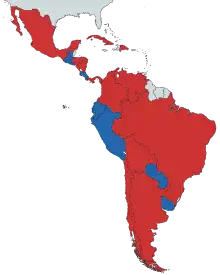Portal:Latin America
|
|
Portal maintenance status: (April 2019)
|
|
| ||||||||||||||||||||||||||||||||||
Latin America articles | |||||||||
|---|---|---|---|---|---|---|---|---|---|
| History |
| ||||||||
| Geography | |||||||||
| Politics |
| ||||||||
| Economy | |||||||||
| Society |
| ||||||||
| |||||||||
.jpg.webp)
The 2018 Panama–Venezuela diplomatic crisis was a diplomatic stand-off between Panama and Venezuela after the Panamanian government imposed sanctions on President Nicolás Maduro and several key officials of the Bolivarian government over alleged involvement with "money laundering, financing of terrorism and financing the proliferation of weapons of mass destruction" on 29 March 2018.
On 5 April 2018, Maduro imposed sanctions on Panamanian companies and as well as prominent Panamanian officials, including President Juan Carlos Varela in response to the sanctions imposed by Panama. (Full article...)









.jpg.webp)







North and Central America
Caribbean
South America